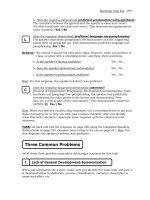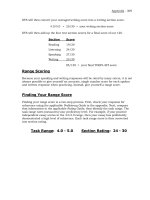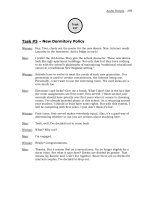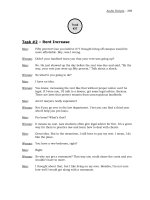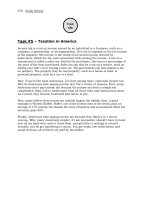Speaking and Writing Strategies for the TOEFL iBT part 32
Bạn đang xem bản rút gọn của tài liệu. Xem và tải ngay bản đầy đủ của tài liệu tại đây (309.44 KB, 10 trang )
Speaking Task Six - 299
b. Does the response demonstrate proficient grammatical unity-synthesis?
The transition between the general and the specific is clear and correct.
All other transitions are clear and correct. This demonstrates grammatical
unity-synthesis. Yes √ No _
Does the response demonstrate proficient language use-paraphrasing?
The speaker objectively paraphrases the main points and the supporting
points with no points left out. This demonstrates proficient language-use
paraphrasing. Yes
√ No _
Delivery: We cannot evaluate the next three steps. However, when you practice in
class, or alone with a recording device, ask these three questions.
a. Is the speaker’s fluency proficient? Yes _ No _
b. Does the speaker demonstrate automaticity? Yes _ No _
c. Is the speaker’s pronunciation proficient? Yes _ No _
Note: For this response, the speaker’s delivery was proficient.
Does the response (argument) demonstrate coherence?
Because of Organization, Progression, Development-summarization, Unity-
synthesis and Language Use-paraphrasing, the speaker has proficiently
summarized the main points in the lecture and demonstrated “how
bats are a critical part of the environment.” This demonstrates coherence
(OPDUL=C). Yes √ No _
Note: When you practice constructing responses, use a recording device or get your
class and instructor to help you with your revision checklist. After you identify
areas that lack coherence, repeat the same response until the coherence level
increases.
TASK: Go back and rate the response on page 296 using the Integrated Speaking
Rating Guide on page 324. Compare your rating to the one on page 341. Note
: For
this response, the speaker’s delivery was proficient.
Avoid these three problem areas when delivering a response for this task.
When you summarize the lecture, make sure you identify the main topic and how it
is developed either by definition, process, classification, narration, description or
cause-and-effect, etc.
L
C
Three Common Problems
Lack of General Development-Summarization
1.
300 - Speaking Task Six x
A lack of general development-summarization (OPDUL=C) will result
in a lack of unity-synthesis (OPDU
L=C), specifically topical unity
between the general (G) and the specific (3TiC). This will result in a
lack of coherence (OPDUL=C
) and a lower score.
When you summarize the lecture, make sure you identify the correct number of
supporting illustrations (TiC, 2TiC, 3TiC). Also, make sure you identify the cause-
and-effect relationship in each. The cause-and-effect relationships are the reasons
that support and develop each example which, in turn, “add to and support” the
general topic.
A lack of specific development-summarization (OPDUL=C) will result
in a lack of unity-synthesis (OPDU
L=C), specifically topical unity
between the general (O) and the specific (3TiC). This will result in a
lack of coherence (OPDUL=C
) and a lower score.
When you summarize the lecture, make sure you use the correct verb tense. If you
start off using the simple present (The lecture says
that…), do not change to simple
past (The lecture said
that…)
Mixing verb tenses demonstrates a lack of unity-synthesis,
specifically a lack of grammatical unity (OPDU
L=C). This will result in
a lack of coherence (OPDU
L=C) and a lower score.
Listed below are reasons why your response is longer than 60 seconds.
Reason #1 Your summarization of the general topic is too long.
Solution 1. Make your summarization shorter.
2. Avoid details like dates, places, costs, etc.
3. Speak faster; try not to hesitate.
Reason #2 When the clock starts, you are not speaking right away. That means
you are losing valuable seconds at the start.
Solution 1. Start speaking right after the beep. Remember: The
speaking tasks come up fast. Be ready for them.
Remember!
Lack of Specific Development-Summarization
2.
Mixing Verb Tenses
3.
Remember!
Remember!
Help! – My Response is Too Long!
Speaking Task Six - 301
Reason #3 You are being too careful. When you are too careful, you slow down
to pronounce correctly. When you slow down, you waste time. You
also decrease fluency and automaticity.
Solution 1. Speak at a normal pace.
2. Record your voice, then play it back. You will know if you are
speaking too slowly. If so, speak faster.
Reason #4 You are pausing or hesitating too much. Record your voice and
play it back. You will soon know if you are pausing or hesitating too
much. Pausing and hesitating wastes time. Pausing and hesitating
will also decrease fluency and automaticity.
Solution 1. Avoid pauses; try not to hesitate.
2. Practice reading the sample responses.
3. Ask a native speaker to demonstrate the right speed.
Reason #5 You are pausing or hesitating too much because you did not
summarize the lecture using G+3TiC=C.
Solution 1. Memorize G+3TiC=C.
2. Practice one response over and over until you are confident
summarizing the lecture using G+3TiC=C.
Reason #6 Your summarization of the lecture contains too much information.
Solution 1. Identify only the main topic in each supporting illustration and
the supporting illustrations.
2. Reduce the number of details (dates, costs, ages, etc).
Reason #7 The conclusion is too long.
Solution 1. State the conclusion in one sentence.
2. State the conclusion in 5 seconds or less.
Reason #8 The clock makes you so nervous you blank out.
Solution 1. Do not time yourself when you practice. Just speak. When you
are more confident, time yourself.
302 - Speaking Task Six x
Listed below are reasons why your response is too short.
Reason #1 You are nervous. When you are nervous, you speak too fast and
finish too soon.
Solution 1. Record your voice and play it back. You will soon know if you are
speaking too fast. If so, slow down.
2. Do not time yourself. Just speak at a regular speed.
Reason #2 Your summarization of the lecture is too short.
Solution 1. Make sure you have identified the main topic in the general
introduction.
2. Make sure you have identified the each supporting illustration in
the body.
Reason #3 You speak, then suddenly stop because you are shy or afraid, or
feel stupid.
Solution 1. Practice reading into a recording device. Read an English
magazine article or a book while recording. This will help you
develop confidence speaking into a microphone.
2. Take an ESL class to develop your speaking skills and
confidence.
3. Practice. Practice. Practice.
Reason #4 You are not confident using G+3TiC=C.
Solution 1. Practice developing and delivering one response until you have
memorized G+3TiC=C and can remember it automatically
without notes.
2. Practice. Practice. Practice.
Reason #5 You blank out.
Solution 1. You are trying too hard or are too nervous. Try to relax. When
you practice speaking, don’t time yourself, just speak until you
are confident. When you are more confident, then time yourself.
2. Don’t worry about fluency, automaticity and pronunciation, just
speak. The more you speak, the more confident you will become.
Start clean, end clean.
Help! – My Response is Too Short!
Remember!
Speaking Task Six - 303
What if you can’t deliver a response for this task? What if you blank out? What
should you do? Follow these two steps and deliver an emergency response.
After you listen to the lecture, look at your note map. Try and identify
the main topic. The main topic is the most important part of this
task. If you can identify the main topic, you might be able to
remember the premise and the supporting illustrations.
If you can remember only one point from the lecture, make sure it is
the main topic.
If you can only remember the main topic—and not the supporting
illustrations—then develop the main topic only.
Don’t stop talking. The more you talk, the more you think. The more
you think, the more you might remember the main topic and the
supporting illustrations.
Remember!
Remember!
Emergency Response
Identify the main topic (20 seconds).
Step #1
Speak (60 seconds).
Step #2
